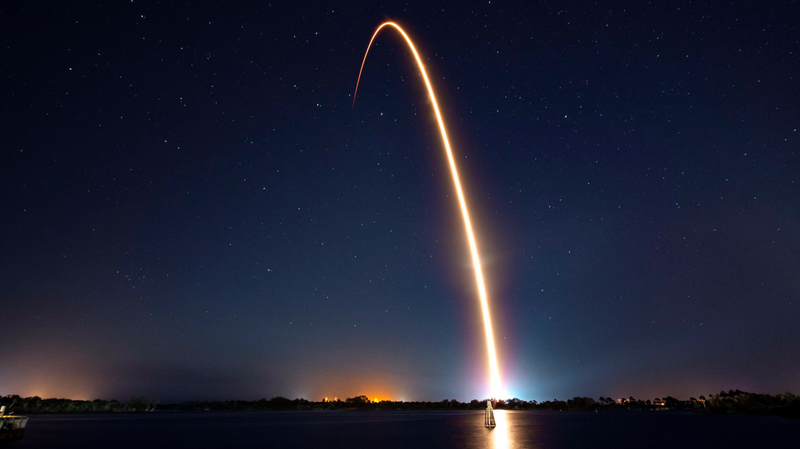
Israel has taken an important first step to the Moon following the launch of its privately-built Beresheet lunar lander, which entered space late yesterday aboard a SpaceX rocket.
The SpaceX Falcon 9 rocket departed Earth at 8:45 p.m. ET on Thursday, February 21 from Cape Canaveral Florida, reports SpaceNews. In addition to the Beresheet lunar lander, the rocket successfully delivered the Indonesian Nusantara Satu telecommunications satellite and the S5 experimental smallsat owned by the U.S. Air Force.
Advertisement
The launch of Beresheet, which means “Genesis” or “In the beginning” in Hebrew, represents a significant milestone for both Israel and the private sector. The four-legged lunar lander represents the country’s first attempt to land on the Moon, but it also happens to be the first privately-funded lunar lander. Should the mission be successful, Israel would join an exclusive club of countries to have placed a lander on the Moon, the others being the United States, Russia, and China.

Beresheet was built by the Israeli not-for-profit SpaceIL, which is financed by donations from individual private sponsors. The company’s self-described vision is to “advance the discourse on science and engineering in Israel and to acquaint the young generation with the exciting opportunities in their future, which STEM studies make possible.”
Advertisement
To save on fuel, the spacecraft is taking a more convoluted route to the Moon than usual. As the Associated Press reports, Beresheet’s orbit around Earth will increase in size until the Moon’s gravitational tug is strong enough to capture the craft. An attempted landing at the Sea of Serenity—a large, dark, basaltic plain also known as a lunar mare—is likely to occur on April 11.
During its descent, the spacecraft will measure the Moon’s magnetic field, potentially revealing new details about iron core deep below, reports the New York Times. The landing sequence should take about 15 minutes—a delicate procedure that’ll be monitored by a joint group from the Israel Space Agency, NASA, and the Weizmann Institute of Science, reports the Jerusalem Post.
Once planted on the Moon, Beresheet will transmit photos and videos back to Earth, per SpaceNews. The probe is also equipped with a series of mirrors known as retroreflectors. Lasers from the surface of Earth will shine onto these mirrors and then reflect back to Earth, enabling scientists to measure the distance from Earth to Moon with high accuracy, the NYT reports.
Advertisement

Beresheet was originally designed to compete for the $20 million Google Lunar X Prize, which was discontinued on January 23, 2018 because “no team will make a launch attempt to reach the moon by the March 31, 2018, deadline,” in the words of X Prize founder and chairman Peter Diamandis. As a stipulation of the contest, lunar probes were required to move 500 meters (1,640 feet) by whichever means possible. Beresheet was supposed to achieve this by taking off and landing again nearby, but as the NYT pointed out, mission planners are no longer bound by this requirement. A decision to make the lunar hop won’t be made until after the landing in April, but there’s really nothing to gain from such a maneuver—one that could unnecessarily damage the probe.
The Beresheet mission will only last for a few days, as the lunar lander won’t be able to withstand the temperature extremes on the surface. But its legacy will endure in the form of its cargo; the probe contains hundreds of digital files, including the Torah, the Israeli flag, artwork, and an archive containing 30 million pages of information, the NYT reports.
Advertisement
“Congratulations to SpaceIL and the Israel Space Agency,” said NASA Administrator Jim Bridenstine in an agency press release. “This is a historic step for all nations and commercial space as we look to extend our collaborations beyond low-Earth orbit and on to the Moon.”
As for the SpaceX Falcon 9 that delivered the goods, its first stage booster made its third successful trip into space, and it landed successfully on a drone ship in the Atlantic ocean. In a tweet, however, Musk said the re-entry was not without incident.
Advertisement
Despite the challenge, Musk said the first stage rocket will be used for a fourth launch in April.
[SpaceNews, Associated Press, New York Times, Jerusalem Post]
https://gizmodo.com/historic-israeli-mission-to-the-moon-underway-following-1832815803Bagikan Berita Ini














0 Response to "Historic Israeli Mission to the Moon Underway Following SpaceX Launch - Gizmodo"
Post a Comment